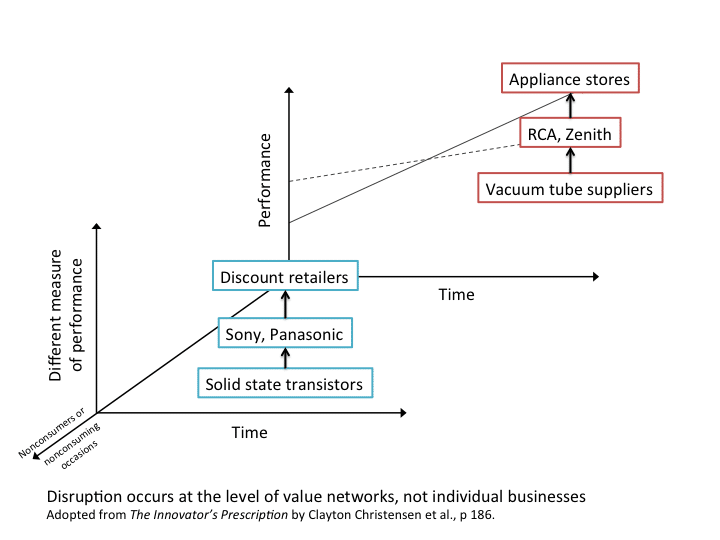Health care’s inefficiency and potential for disruption have telemedicine and other tech startups stampeding for the new gold rush. The easiest way to get attention in the crowd? Call yourself “disruptive.” Perhaps thanks to the hype, disruptive innovation has become one of the most frequently used, yet least understood concepts in modern business jargon. What many don’t realize is that it takes more than a radical product to disrupt. Inreality, disruption consists of:
- A sophisticated technology that is “worse” in traditional ways, but better in new ways that matter to different people
- A novel business model that targets nonconsumers, or people who couldn’t consume old solutions due to access or cost
- A coherent value network that covers the upstream and downstream needs of the novel company
The last of these conditions – a coherent value network – is often overlooked, especially in the tech space. No technology exists that is specially imbued with disruptive properties. Instead, disruption happens on the level of value networks, when an entire commercial ecosystemreplaces another.
Consumer electronics in the 1950s is a good case example. At the time, mainstream consumer electronics like RCA and Zenith were using short-lived vacuum tubing components – and their distributors actually generated a lot of revenue by replacing burned out vacuum tubes every few years. Sony and Panasonic entered the market with cheap, portable products using solid-state transistors. By the 1970s, the more reliable solid-state transistors entrants had mostly toppled their vacuum tube predecessors. And this wasn’t a “one-for-one” substitution – the entire value network was gradually replaced by new suppliers and distributors (like Wal-Mart and Kmart). This is because in the old value network, the way suppliers and distributors made money was dependent on the profit margins and model inherent to vacuum tubes. Wal-Mart and Kmart, on the other hand, matched the high-volume, low-margin business that Sony and Panasonic could profit from.

The key mistake that most healthcare entrants make is to compromise too much with the existing value network. For better or worse, the old value network is organized around generating value in a certain way. In the resource allocation process, which includes negotiation and plugging into existing operations, the technology can easily morph from an ambitious, disruptive application to one that reflects the old profit, resource, and process constraints of the more entrenched organization.
In telemedicine, we’ve hypothesized that most applications to date sustain instead of disrupt the old delivery model. This is the result of trying to make a novel delivery technology fit with an old system.
If telemedicine services are only realized as a sustaining innovation, they may only have value for one-and-done acute conditions. For telemedicine to be applied in a more broadly impactful, disruptive way, it needs to be used to treat chronic conditions. The key barriers to this are almost certainly interoperable EHRs and reimbursement issues. This model will require highly functional EHRs that follow the patient from provider to provider. And until reimbursement (insurers and deductible/out-of-pocket costs) aligns with new payment methods to manage chronic disease, then disruptive telemedicine companies won’t be profitable, even if they address real market and patient needs.
As discussed in a previous post, most telemedicine might not be “as good” as the traditional doctor’s visit in all facets – but that’s exactly why it has disruptive potential. Incumbents who face increasing cost burdens will be glad to offload less profitable tasks onto lower-cost-structure providers who can manage these unprofitable conditions. When these factors begin to converge, the opportunity for a truly disruptive commercial ecosystem to coalesce grows more realistic. Until then, improvements in telemedicine may have potential in other places, including the humanitarian effort to bring care to rural areas, and some very interesting applications in post-market drug validation and regimen adherence. The slam-dunk disruptive potential of telemedicine has yet to be realized. But as new value network pieces fall into place, the sky is certainly the limit.

